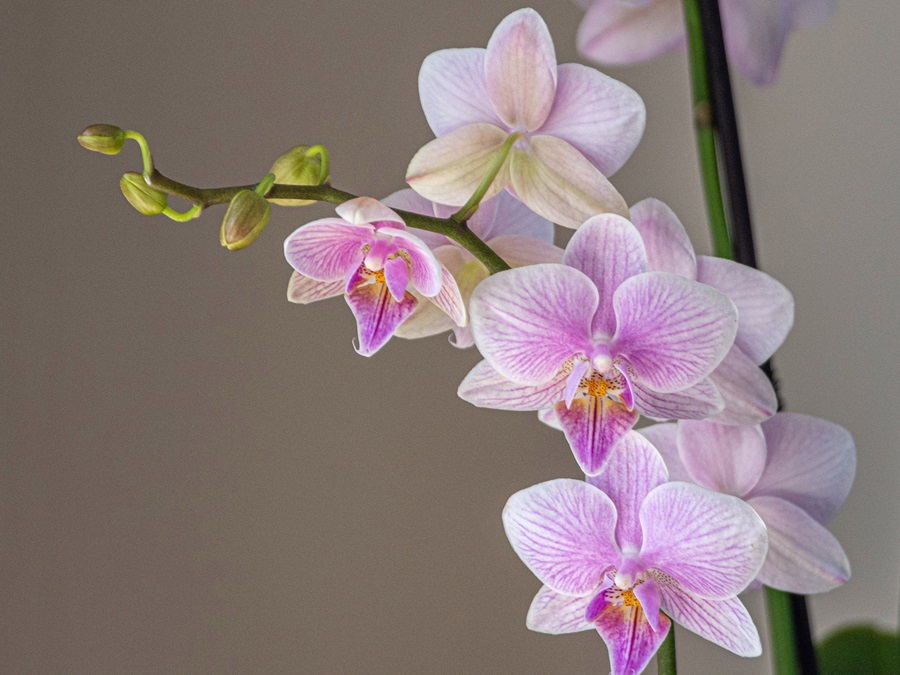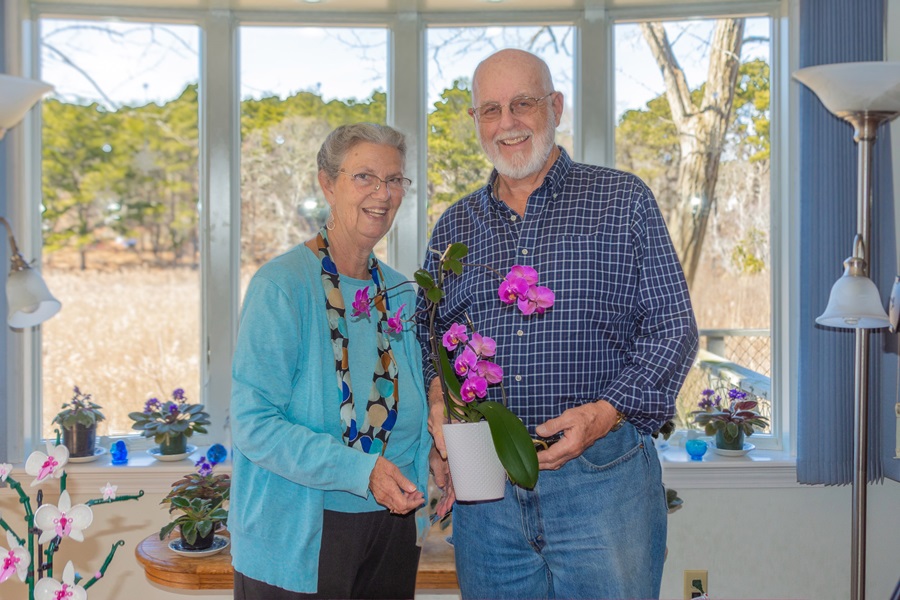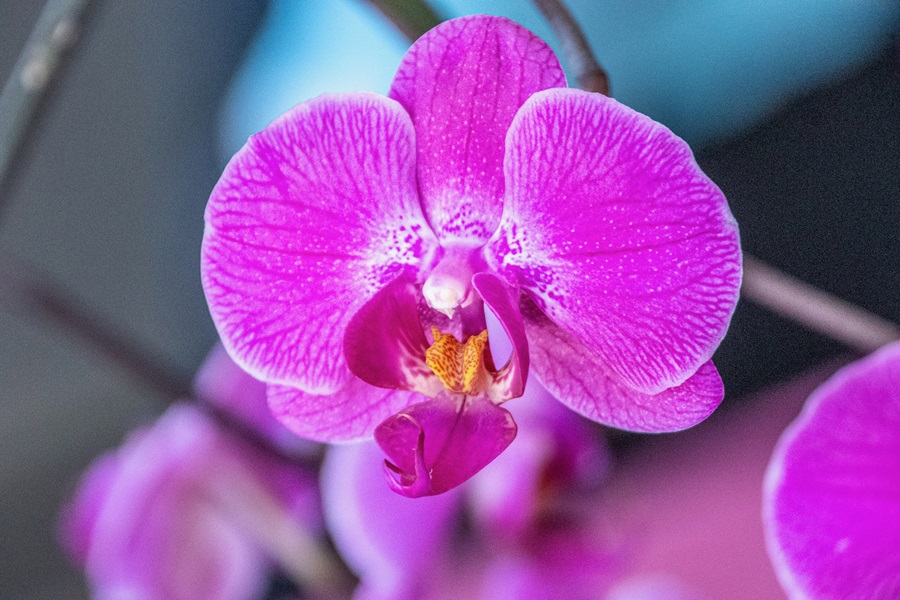There is one orchid in Christine and Alan Hight’s house in Wellfleet, a Cattleya or corsage orchid, that took 10 years to bloom. Each year, it would “spike” — a small bud would peek out from the stalk, and Christine’s heart would leap. And then the bud would turn out to be just another leaf.
The Hights are tending more than 20 orchids right now. The best-looking ones — the ones with dark green leaves and proud white or magenta blossoms — earn a spot on a wooden table in the dining room next to the window. A handful preside over their bedroom; another is perched atop their powder-blue toilet. There’s not a lot of light in the bathroom, but the plants enjoy the steam from the shower.

Alan, a former Wellfleet fire chief, and Christine fell for orchids about 20 years ago. They were in Falmouth in late January to celebrate their wedding anniversary, and the winter air was cold and harsh. They descended into the basement of the Sea Crest Resort, where the Cape Cod and Islands Orchid Society was holding its annual show. In Christine’s telling, that moment was a little like falling in love — a moment of heightened awareness, when the smells and colors of the world suddenly felt more vibrant.
“I stepped downstairs and was immediately hit by the humidity, the scent,” Christine says. Orchids’ aromas vary widely, but the sweetly scented ones have been described as smelling like lily of the valley, honey, citrus, and vanilla. That day Christine was transfixed, becoming another victim of what the Victorians termed “orchidelirium” — that is, orchid obsession.
Orchids have induced mania, what writer Susan Orlean calls “a sort of lovesickness,” for centuries. Some Victorians braved the depths of unexplored jungles to bring home the rarest species. In her 1995 New Yorker article “Orchid Fever,” Orlean describes how collectors have sometimes emptied their bank accounts to acquire the plants.
The Hights aren’t that extreme. If the Victorian orchidists were ready to throw away everything for orchids, as if caught up in a passionate affair, then the Hights are more consistent, stable partners. They’re the ones who orchids would introduce to their parents. Alan tends to the plants every Sunday like clockwork. He checks the moisture of the moss or bark that the orchids are planted in and rids them of any insects or scales. If there are any orchids in keiki, meaning that a clone is emerging from a node on the flower stem, he mists those daily.
Though the Hights have been collecting and cultivating orchids for 20 years, they say they are still amateurs. They do not experiment with hydroponics, do not pump their greenhouse full of steam, do not weigh their plants before watering them.

Their love of orchids does not require mastery or perfection. Though the Hights grow several varieties and have tried many others, they mainly grow Phalaenopsis, a genus of about 70 species in the Orchidaceae family, because they are less fragile than others: they thrive at room temperature, from 55° to 70° F, “the same as what humans like,” Alan says, and need only diffuse light cast from a window. Otherwise, they have that one Cattleya and some Miltonias and Dendrobiums.
Orchids are finicky creatures, and those who are drawn to them are often obsessive about their care. It seems incongruous, then, that the Cape and Islands Orchid Society’s acronym, CAIOS, is pronounced “chaos.” Christine is now the society’s membership officer, and she says that part of the pleasure of the group is its disorder.
Though orchids demand close attention, the society encourages a spirit of learning and experimentation — in this way, Christine says, they have earned their provocatively pronounced acronym. The society invites speakers to its monthly Sunday meetings at the fairgrounds in Falmouth, and each meeting boasts a potluck and a raffle for members to trade their orchids.
That orchids are needy and particular is a fact their appearance seems to announce. The Phalaenopsis’s flowers look delicately, precariously hung; the plant seems to arch its spindly stem in repose. The orchids themselves seem to know they are flamboyant, strange, and totally out of context in a New England winter.

Most orchids originate in the tropics and are epiphytes — plants that grow on other plants but are not parasitic — growing horizontally from the sides of trees, Christine says. Even putting an orchid in the car in March and driving it to Yarmouth to show off at a meeting is to risk its life.
Though the lovelier blossoms are on display in the Hights’ dining room, there is another room in the house where those in dire straits live. Some have been brought by friends. A spare bedroom on the second floor has the feel of a plant hospital. Here are the wounded and ailing orchids — one with a burn from overexposure to the sun, another with a withered stem. They live under a pink grow light, and even when the plants are failing, the Hights find it difficult to get rid of them.
“One woman told me, ‘I prefer to think that they chose not to live with me rather than that I killed them,’ ” says Christine. “I liked that.”
There’s satisfaction in nursing a plant back to health. But watching the plants flower is the most rewarding part of cultivating orchids, Christine says. “And they stay in bloom for a while,” she adds, many for as long as three months.
For most of the year, though, the plants are not blooming. So, “one year, we tried to figure out which ones we like the greenery of, because that’s what we’re going to see most of the time,” says Alan. Years will pass until some of their orchids will blossom. The Hights are prepared to wait.
